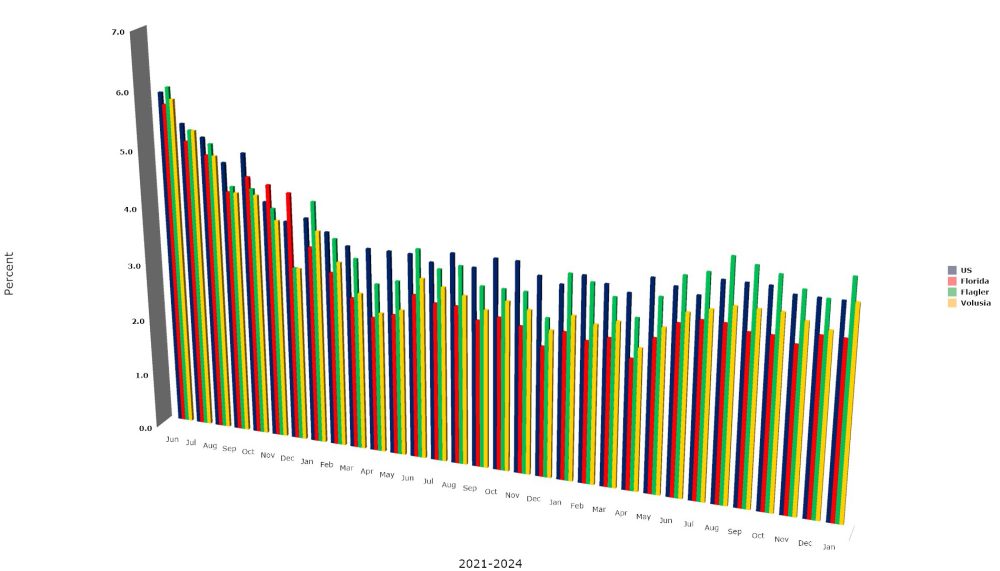
Flagler County’s unemployment rate again crossed the 4 percent threshold, for the fourth time in six months, registering at a not-seasonally adjusted 4.1 percent in January, up from 3.7 percent in December and 3.6 percent a year ago. The more telling average of the last 12 months was 3.7 percent, compared to 3.3 percent for the previous 12 months, underscoring a small but perceptive trend upward.
Flagler County’s rate is the 13th highest out of 67 Florida counties, with Putnam at 4.2 percent, Volusia at 3.7 and St. Johns at 3 percent. The county with the lowest rate by far was Miami-Dade, at 1.4 percent. (Over 10 percent of the state’s manufacturing jobs are in Miami-Dade, with 42,200 jobs with average wages of $74,588, according to the Commerce Department.)
Florida’s rate was 3.1 percent, matching the revised rate of December, which the Commerce Department had originally reported at 2.9 percent. Florida’s average unemployment rate over the past 12 months is 2.9 percent, compared to 2.9 for the previous 12 months.
One reason for Flagler’s unemployment increase is that the labor force continued to grow, as it has slowly but steadily for the past several years, adding 166 workers in January and 1,437 since last January. But the number of job holders did not grow apace. The number of Flagler residents with jobs declined by 32, to 49,618, and the number of people without jobs–the unemployed–increased by 198, to 2,130. That is the second highest number of unemployed persons in the county in two and a half years, with one exception: there were 2,185 people without jobs last August. (The previous high figure was 2,377 in 2021.)
To be registered as an employed person, a Flagler County resident has to have worked at least one hour in the previous period examined by the jobs report. The location of the job is irrelevant. Unemployment figures are recorded by residency, not job location, so Flagler residents registered as employed may be holding full or part-time jobs in the county, in any of the surrounding counties, or by telecommute. The jobs report does not break down those categories. Nor does it distinguish between full time or part time work, or between the voluntary part-time workers and those working part-time only because they couldn’t find full-time work.
Nationally, there were 4.4 million workers employed part-time for economic reasons–because they couldn’t find full-time work. There were 2 million workers who were either marginally attached to the labor force or had stopped looking for work altogether.
Florida keeps its official unemployment rate deceptively low thanks to the state’s draconian rules for the unemployed. Those rules require unemployed persons regularly to prove that they are looking for work, while their unemployment benefits, at $275 a week the lowest in the nation, run out after 12 weeks. Once the unemployed are off the rolls, they are no longer counted as unemployed. The federal Labor Department’s Alternative Measure of Labor Underutilization does include those working part-time involuntarily as well as discouraged workers who are no longer looking for work. That rate for Florida is currently 5.9 percent, or 2.8 percentage points higher than the official rate the state is reporting. The national rate is 6.9 percent. (See the alternative rate for all states here.)
The state added 38,800 jobs in January, for an increase of 259,600 jobs over the year, resulting in a labor force of just over 11 million and 340,000 officially jobless Floridians. Most sectors gained jobs or stayed flat, with more pronounced gains in construction, retail, finance and insurance, real estate, health care and social assistance, and a very strong 1.6 percent gain (the highest proportional increase of all sectors) in arts, entertainment and recreation, and a 1 percent increase in federal jobs. There were decreases in state government jobs, management, and transportation and warehousing.
![]()
february-2024-jobs-florida










